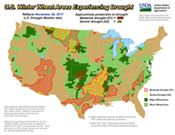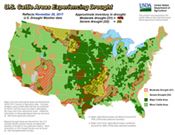|
Drought Cutting Into Forage; Puts Stress On Fledgling Winter Wheat Crop
LITTLE ROCK, ARK.
Arkansas’ drought-ridden fall could turn into three seasons of trouble for livestock and forage producers; as winter wheat growers hope for another decent rain to keep their crop developing.
The Dec. 7 Drought Monitor map shows 98 percent of Arkansas in drought this fall, with the most intensively dry area, listed as “extreme drought,” affecting 22 counties stretching from central Arkansas to the Oklahoma state line.
In its final report of the year on Nov. 26, the National Agricultural Statistics Service said 56 percent of winter wheat in Arkansas was in good condition, with 5 percent excellent. Thirty-percent was fair and 8 percent poor.
Pasture wasn’t faring so well with 25 percent in good or excellent condition, 29 percent fair, 32 percent poor and 14 percent very poor.
On Nov. 30, the National Weather Service at Little Rock called the month “The driest November and driest fall on record in portions of Arkansas.”
North Little Rock, Little Rock Air Force Base and Monticello all had their driest Novembers on record. Pine Bluff, North Little Rock, Russellville, Little Rock Air Force Base, Calico Rock, Mount Ida and Monticello all reported their driest-ever falls.
“Several long-standing records have been broken,” the weather service said. “At Russellville, this has been driest fall since 1897, and at Mount Ida, this has been the driest fall since 1879!”
Double-edged sword
“A dry fall for Arkansas wheat growers is a double-edged sword,” said Jason Kelley, extension wheat and feed grains agronomist for the University of Arkansas System Division of Agriculture. “We need dry weather to harvest fall crops and get wheat planted, but prolonged dry weather has caused some issues with thin or variable stands in some fields this year.
“November is typically a wet month for us. Most areas have finally received a good rainfall with the last weather system, but some wheat will be very late emerging,” he said. “Late emerging wheat may not have the tiller production needed to reach full yield potential.”
Drought-stressed wheat has been seen in many areas in November, “a rarity for us,” Kelley said. “The rainfall we received this week should be adequate for a while. Fortunately, most of the wheat grown in the state is in the delta, which has received more rain than areas in central and southwest Arkansas.”
Three seasons’ impact
John Jennings, professor-forage and extension specialist for the Division of Agriculture, said that a dry fall can have more overall negative impact on annual forage production than a dry summer for three reasons:
• It reduces late summer/fall forage production which is critical for fall and winter grazing
• Delays planting of winter annual forages that would otherwise be grazed in fall/winter
• Reduces plant development and increases cold temperature stress which can delay spring green-up and early spring grazing.
“So, a dry fall can have negative impact on three seasons of the year,” he said, adding that this year, he’s anticipating the following effects:
Early hay feeding – “The lack of fall pasture growth caused many producers to start feeding hay in late September and in October,” Jennings said. “This will put pressure on those with limited hay in storage. Also, much of the hay harvested this summer is medium to low quality due harvest delays caused by summer rains. Ironic that the summer was too wet for a good quality hay crop and the fall is too dry to make up for it.”
Late fall planting – “Many producers plant wheat or ryegrass in fall for winter grazing,” he said. “Much of the planting was greatly delayed or eliminated due to the dry conditions. So, the good quality forage normally available in late winter on many farms will not be available this winter.”
Dry weather desiccation from freezing weather – “Dry winter conditions can cause more damage to forages than wet conditions,” Jennings said. “The reasons being that short drought-stressed forages – in this case winter annuals like wheat and ryegrass – provide little ground cover to insulate the soil from extreme temperature fluctuation.”
He said that air fills the soil pore space and is a poor insulator against freezing.
“Winter annuals still respire during winter but have little soil moisture to pull from,” Jennings said. “During extreme cold, these plants can literally freeze-dry causing stand thinning or loss. Dry winter conditions can also lead to injury of cold-sensitive bermudagrass varieties if extreme cold temperatures occur.” ∆

Images courtesy National Agricultural Statistics Service.

|
|